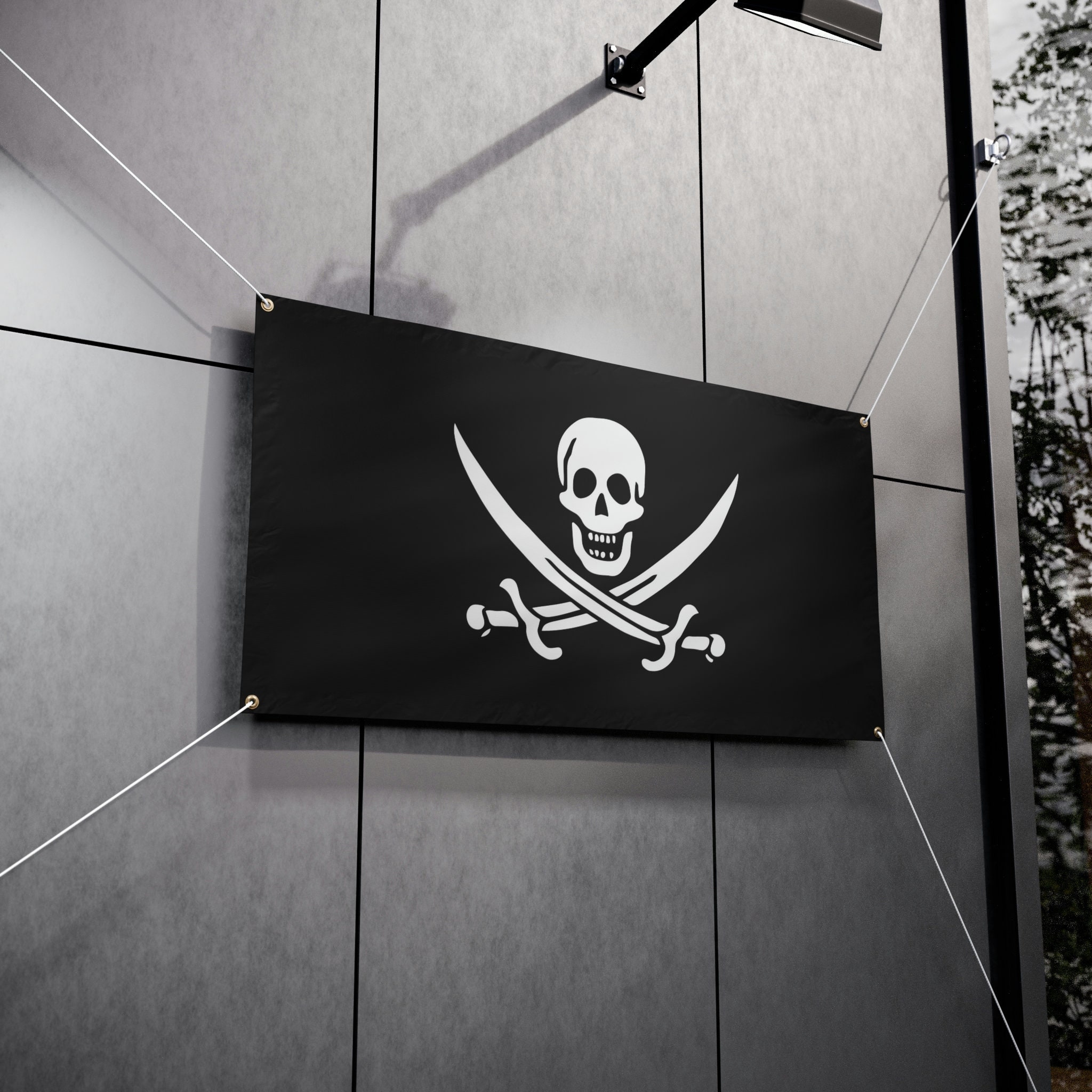Outdoor Vinyl Banner, 48"x24", Skull & Crossed Cutlasses, Pirate Flag, Jolly Roger, Calico Jack's Flag, John Rackham
$44.95
More pirate gear: https://www.vintageartwork.com/search?q=pirate
This design is from the historical pirate flag of John Rackham, more commonly known as Calico Jack. John Rackham was an English pirate captain operating in the Bahamas and in Cuba during the early 18th century. His nickname was derived from the calico clothing that he wore, while Jack is a nickname for "John". Calico Jack was active towards the end (1718–1720) of the "Golden Age of Piracy" which lasted from 1650 to 1730. He is mostly remembered for having two female crew members: Mary Read and his lover, Anne Bonny.
Please note that this item is not a two-sided cloth flag, but a one-sided vinyl banner designed to be mounted against a flat surface, like a wall or fence.
This one-sided vinyl banner is the ultimate solution for showcasing your message with style and durability. Made from top-grade 10 oz. Titan™ scrim vinyl, this banner is designed to be long-lasting and visually appealing, ensuring that it stands out in any setting.
The material's strength and durability make it suitable for both indoor and outdoor use, so whether you're showing off your patriotism, promoting your business at a trade show, celebrating a special occasion, or using it as a sign for your storefront, this versatile banner has you covered.
This vinyl banner features heat-welded hems, which reinforces the edges and prevents fraying. This added reinforcement ensures your banner remains in pristine condition and maintains its professional appearance even after extended use. The banner also comes with grommets placed in all four corners, providing secure and easy mounting options for various applications.
Please note that hanging strings or hooks are not included with the purchase of this banner. However, with the grommets in place, you have the flexibility to choose the hanging method that best suits your needs.
.: Size: 48"x24"
.: Material: Titan™ 10 oz. scrim vinyl
.: Vibrant, single-sided printing for eye-catching visuals
.: Features heat-welded hems and grommets
.: Suitable for indoor and outdoor use
.: Hanging strings or hooks not included
Shipping from United States
Processing time
1-7 business days
Customs and import taxes
Buyers are responsible for any customs and import taxes that may apply. I'm not responsible for delays due to customs.
Payment Options
Returns & Exchanges
I gladly accept returns and exchanges
Just contact me within: 14 days of delivery
Ship items back to me within: 30 days of delivery
I don't accept cancellations
But please contact me if you have any problems with your order.
The following items can't be returned or exchanged
Because of the nature of these items, unless they arrive damaged or defective, I can't accept returns for:
- Custom or personalized orders
- Perishable products (like food or flowers)
- Digital downloads
- Intimate items (for health/hygiene reasons)
Conditions of return
Buyers are responsible for return shipping costs. If the item is not returned in its original condition, the buyer is responsible for any loss in value.
Frequently Asked Questions
What is All-Over-Print (AOP)?
All-Over Print (AOP) is a printing method that uses dye-sublimation to print a design onto polyester. During the dye sublimation process the dye is absorbed into the fabric. Since, it is not printed on the surface, like most t-shirts, it provides for a fantastic soft-to-the-touch feel and superior breathability.
AOP is a more time consuming method than screen printing or direct-to-garment (DTG) printing, so the prices are higher and the production times are longer, but the results are most definitely worth it.
Advantages of AOP:
The design won't peel off, unlike typical screen printing.
The design is part of the fabric of the item, so it will last as long as the item does.
The intensity of color is often unmatched.
What is Giclée?
Giclée (pronounced zhee-CLAY or often gee-CLAY) is a printing process that creates a museum quality, archival print. Special acid-free, paper is printed with fade resistant ink using a state-of-the-art, large format inkjet printer.
What is a gallery wrap canvas?
Gallery wrap is a style of displaying a canvas that doesn't show any visible staples or nails holding the fabric to the wooden stretcher bars. This style of canvas is intended to be hung unframed.
What is a gallery mirror wrap canvas?
Mirrored edges (mirror wrap) is used to show the whole image on the main surface, rather than printing the edges of the image on the sides (image wrap) of the canvas frame. It is usually used when there is necessary detail on the edges of the image. Image wrap is used when the focal point of the image is in the center.



